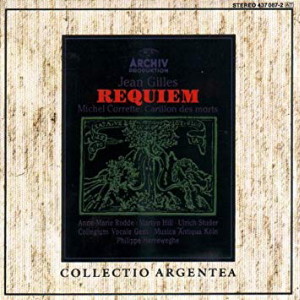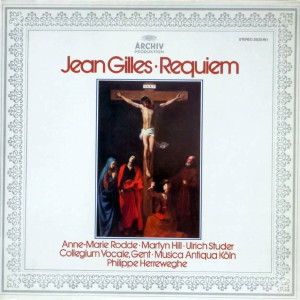 |
|
1 CD -
437 087-2 - (c) 1986
|
 |
| 1 LP -
2533 461 - (p) 1981 |
|
| JEAN GILLES -
Requiem |
|
|
|
|
|
Jean
Gilles (1668-1705)
|
|
|
| Messe des morts
(Requiem) |
|
|
| - Introitus |
14'
13" |
|
- Kyrie
|
2'
22" |
|
| - Graduale |
5'
12" |
|
| - Offertorium |
9'
43" |
|
| - Sanctus |
3'
57" |
|
| - Agnus Dei |
4'
00" |
|
| - Communio |
4'
32" |
|
|
|
|
| Michel
Corrette (1709-1795) |
|
|
| Carillon des
morts |
4'
46" |
|
|
|
|
| Anne-Marie Rodde,
Sopran |
COLLEGIUM VOCALE
GENT |
|
| Jean Nirouët,
Altus |
MUSICA ANTIQUA
KÖLN / Philippe Herreweghe,
Leitung |
|
| Martyn Hill,
Tenor |
- Reinhard Goebe, Marie
Leonhardt, Mijoko Kimura, Barock-Violine |
|
| Ulrich Studer,
Bass I |
- Anne Röhrig, Antoinette
van den Hombergh, Barock-Violine |
|
| Peter Kooy,
Bass II |
- Karlheinz Steeb, Hajo Bäß, Barock-Viola |
|
|
- Jaap ter Linden,
Rainer Zipperling, Barock-Violoncello |
|
|
- Jonathan Cable, Violone |
|
|
- Wilbert Hazalzet,
Philippe Suzanne, Traverflöte |
|
|
- John David Mings, Barock-Fagott |
|
|
- Henk Bouman, Orgel-Positiv |
|
|
|
|
|
Luogo
e data di registrazione |
|
Karmeliter
Kerk, Gent (Olanda) - gennaio 1981 |
|
|
Registrazione:
live / studio |
|
studio |
|
|
Producer /
Engineer |
|
Andreas
Holschneider - Gerd Ploebsch /
Onno Scholtze |
|
|
Prima Edizione
LP |
|
Archiv
- 2533 461 - (1 lp) - durata 48'
50" - (p) 1981 - Analogico |
|
|
Edizione
"Collectio" CD |
|
Archiv
- 437 087-2 - (1 cd) - durata 48'
50" - (c) 1986 - ADD |
|
|
Note |
|
- |
|
|
|
|
JEAN
GILLES:
REQUIEM MASS
Gilles,
born in Tarascon, spent his
early years of musical
training under Poitevin at
Aix-en-Provence. He
succeeded his teacher as maître
de musique at the
Cathedral of Saint-Sauveur
in 1693 but within two years
had left the post for a
similar one at the Cathedral
of Agde in the Languedoc.
From there he went to Saint-Étienne
at Toulouse, following in
Campra’s footsteps; a
further appointment followed
at Avignon Cathedral in 1701
but, though for a short
while the 19-year-old Rameau
stood in for him, Gilles
never took up the position.
As far as we know he
remained in Toulouse until
his death in 1705.
During his short life Gilles
composed a considerable
quantity of church music,
mainly psalm settings in the
form of grands motets,
currently fashionable in
France; some of these, as
for instance his Laudate
nomen Domini (Psalm
135), display a striking
individuality of timbre and
melodic invention. Among
the surviving compositions,
two, however, may be
considered to stand out from
the rest. The first of them
is a setting of the Te
Deum,
“a grand choeur et
symphonie”; it was composed
on the occasion of the
signing of the treaty of
Ryswick, news of which
reached Paris on 22
September 1697. Gilles, it
appears from the Mémoires
pour servir à l'histoire
de plusieurs
illustres
de Provence (1752),
completed the work in the
course of a single night and
performed it the following
day. However, since the same
volume also was responsible
for supplying an incorrect
date for the composer’s
birth, we perhaps ought not
to take the anecdote too
literally.
The second of Gilles’
outstanding compositions is
his Messe des morts,
whose date of composition is
not known. Its
history is a curious one;
the families of two deceased
dignitaries of Toulouse
commissioned the work but,
on seeing the elaborate
nature of the finished
product, decided that it
would be too expensive.
Gilles was angry, of course,
and told them that if they
did not want it he would
save it up for his own
funeral - and this is
exactly what he did, taking
care to add a clause in his
will clarifying his wishes.
Sadly, the Requiem was sung
sooner than he could have
expected, and, at his
funeral in Toulouse, the
performance was directed by
Campra, whom Gilles had
known in his student days.
From then onwards the
Requiem became an unusually
popular work, widely known
and, apparently, frequently
performed. Campra was among
those who thought highly of
it and was responsible for
introducing it to Paris and
the French court. In
1764, the year in which it
was published, it was
performed on 27 September at
a memorial service for
Rameau in the church of the
Oratorians in the Rue St.
Honoré.
On that occasion excerpts
from Rameau’s own stage
works, notably his tragédie-lyrique
Castor et
Pollux (1737), were
sung as well. Indeed
it seems as if the Kyrie
actually was sung to
Rameau’s music and not to
that of Gilles on this
occasion. Following Rameau’s
death the work became
popular at the Parisian Concert
spirituel;
and the ultimate accolade,
perhaps, came in 1774, when
the Messe des morts
was sung at a
memorial service for Louis
XV at Versailles.
Outwardly,
the Messe des morts
of Gilles is typical of the
grand siècle
and bears affinity
with the grands motets
of Lalande for example; but
there is also an individual
expression of tendresse,
sensibility and simplicity,
which makes an immediate
appeal. Campra’s own Messe
des morts shows
certain similarities with
that of Gilles and, although
we cannot date his work with
any certainty, it seems
possible that the Requiem
of Campra’s Provençal
contemporary may have acted
as a source of inspiration
to the older composer.
During the 18th century
small permutations occurred
in the textual content of
the Requiem Mass, and
neither of these, for
instance, contains a Dies
irae or Libera
me. Similarities
between the two settings may
also be discerned in the
elegiac string writing, the
lucid textures, the sharp
focus on tonic and dominant
keys and the broad
expressive contours which
far transcend Lullian
formality. It
seems that in 18th-century
Provence the Messe des
morts of Campra and of
Gilles were actually
performed jointly, with
alternating excerpts from
each: on these occasions
regional pride clearly took
precedenceover artistic
integrity.
Nicholas
Anderson
The Requiem by Gilles is
extant in two versions:
a) the primary source, an MS
score (Paris, Bibl. Nat. Vm1
1375)
b) a later version, i. e.
the score printed by Michel
Corrette in 1764, almost 60
years after the composer’s
death. This edition also
includes a “Carillon des morts”
composed by Corrette.
The printed edition differs
from the older MS version in
that certain instruments are
added: thus at the beginning
of the work a drum (Tambour)
anticipates the string
rhythm. The “Te decet
hymnus” section up to the
entry of the voice is played
by an oboe, here making its
only appearance in the
entire work. Evidently the
extra instruments were added
for the performance of the
work on the occasion of
Rameau’s funeral in 1764, to
which the foreword of the
printed edition makes
specific reference. The
present recording is based
on the older, MS source,
which probably represents
the composer’s intentions. In
addition Corrette’s
“Carillon” is also included.
|
|